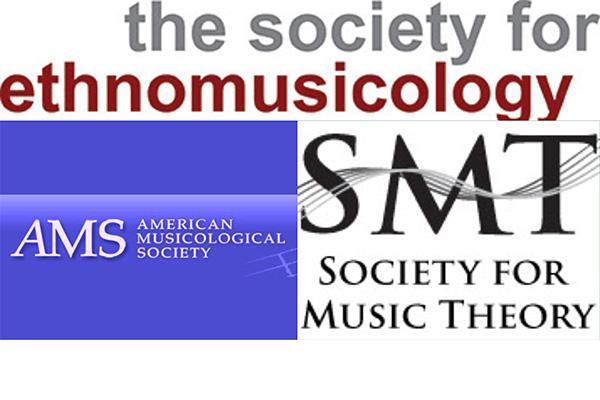Musicology and theory areas present at "music mega-conference"

On November 10–13, the American Musicological Society (AMS), Society for Ethnomusicology (SEM) and the Society for Music Theory (SMT) held a joint “music mega-conference” in New Orleans, Louisiana. It is rare for these groups to meet together. This event represents an exceptional gathering of the three largest music studies societies in the United States, and a sharing of expertise across disciplinary boundaries. Three thousand people attended the meeting.
Eight graduate students and four faculty members from the musicology and music theory areas at Ohio State presented their work at the conference, highlighting the strength, quality and vitality of music research in the School of Music! There were also eight presentations from alumni of our programs.
“It was important for me to be on a panel with ethnomusicologists, for a conversation about global music history.” — Danielle Fosler-Lussier, professor, musicology
“I thought the conference was a really fruitful experience to see how my own and my colleagues' research fits into the larger narratives of the field and to develop new ideas and scholarship alongside those I am actively learning with.” — Larissa Mulder, PhD student, musicology
With twenty total presentations, this was a veritable tour de force of Ohio State music research!
Student presenters included Erin Allen (musicology), roundtable on “Ethnomusicology and Networks: Models, Methodologies and Critical Perspective” (Allen also presented her paper, “Digital Listening and Sonic Assembly in the Virtual Space of the HONK! United Festival During COVID–19” for the annual meeting of the American Studies Association in New Orleans the weekend prior); Emily Kaniuka (Department of Dance), “Pushing Back: Political and Aesthetic Divisions in American Hardcore Punk Moshing;” Jacob Kopcienski (musicology), “Sounding Quare Country: Aesthetics, Mobility and Community Politics of Queer Appalachian Musicians;” Wonseok Lee (musicology), “Entrepreneurial State: The Impact of the South Korean Government on the Musical Diversity of K-pop;” Zachary Lookenbill (theory), “Roll Call: Investigating the Role of Drumline in Drum Corps;” Gerry Lopez (theory), “Vox de Machina: Vocal Significations from the Mechanical to the Robotic;” Larissa Mulder (musicology), “Musical Lament: Irish Women’s Reclamations of a Traditional Practice;” Katelin Webster (musicology), “Sununu: Contesting Refugee Representations through Music in the Third Space.”
Faculty presenters included Arved Ashby (musicology), “Don’t Play Gay: Music, Language and Desire in a Queer Adolescence;” Danielle Fosler-Lussier (musicology), “Global History Research and Music Curricula: Closing the Gap” (Fosler-Lussier also finished up a two-year term as vice president of the AMS); Ryan Skinner (musicology), “The Musical Art of a Cinematic Griot;” Jeremy W. Smith (theory), “Squelching, Wobbling and Whirring: Short Continuous Processes in Electronic Dance Music.”
Alumni presenters included Josh Albrecht (theory), “Tom Waits for No One: Timing and Harmonic misfires as hermeneutic windows into interpreting Waits’ music;” Sophia Enriquez (musicology, Duke University), “La Bruja de Sur: Dia de Los Muertos Ritual, Collaborative Ethnography, and Latinx Musical Ontologies in the U.S. South;” Phoebe Hughes (musicology, SUNY Binghamton), “Taylor Swift: The Star, The Songs, The Fans;” Alejandro Madrid (musicology, Harvard), “The Carrillo Pianos, Materiality, and the Open-Source Archive” (Alejandra also participated in the roundtable “Sound Assumption: The Given of New Orleans and Havana” in addition to chairing the “Committee on Race, Indigeneity, and Ethnicity”); Dana Plank (musicology), “On Ludo-Narrative Acoustemology and Memory Space in Jon Hillman’s Score for That Dragon, Cancer;” Angela Ripley (theory, Texas A&M University, Kingsville), “Playing to Learn: Pedagogical Games in the Music Theory Classroom;” Nicholas Shea (theory, Arizona State University), “Meter versus Harmony as Key Determinant in Popular Music: Which one wins?” (Nick presented another co-authored study at the SMT Music Informatics Interest Group Meeting, “Developing a Stylistically and Demographically Diverse Corpus of Timbral Features in 1990s Popular Music”); Lindsay Warrenburg (theory, Sonde Health), panelist for “Changing Careers: What I Wish I’d Known.”
— Contributed by Ryan Skinner, musicology
